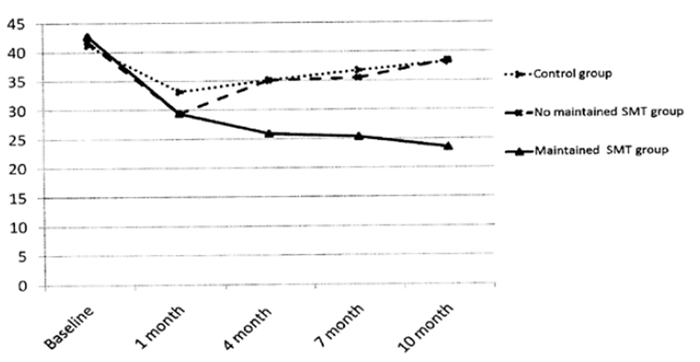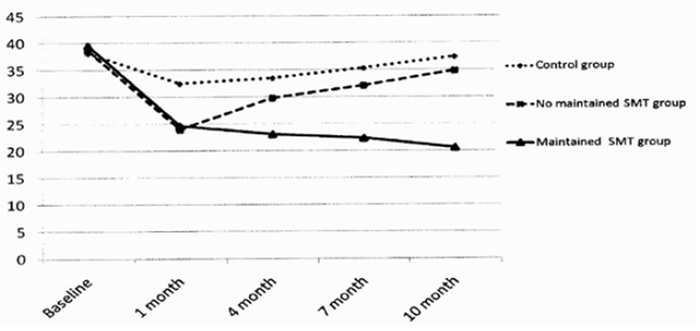

Documentation Supporting Maintenance Care This section was compiled by Frank M. Painter, D.C.
Send all comments or additions to: Frankp@chiro.org




Anthony L. Rosner, Ph.D., LL.D.[Hon.], LLC
As part of a comprehensive geriatric assessment program, the RAND Corporation studied a subpopulation of patients who were under chiropractic care compared to those who were not and found that the individuals under continuing chiropractic care were:
- Free from the use of a nursing home [95.7% vs 80.8%];
- Free from hospitalizations for the past 23 years [73.9% vs 52.4%];
- More likely to report a better health status;
- More likely to exercise vigorously;
- More likely to be mobile in the community [69.6% vs 46.8%].
Recipients of chiropractic care reported better overall health, spent fewer days in hospitals and nursing homes, used fewer prescription drugs, and were more active than the nonchiropractic patients.
Although it is impossible to clearly establish causality, it is clear that continuing chiropractic care is among the attributes of the cohort of patients experiencing substantially fewer costly healthcare interventions. [1]
A second review of a larger cohort of elderly patients across the United States compared direct expenditures [hospital care, physicians' services, nursing home] between groups of patients who were under maintenance chiropractic care and those who were not.
Nearly a threefold savings of mean annual expenditures was reported as follows:
- $ 3,105 : Maintenance care
- $10,041 : No maintenance care [2]
One study involving elderly populations reviewed the consequences of implementing an on-site industrial chiropractic program which included the early detection, treatment, prevention and occupational management of musculoskeletal injuries 2 days per week. For the 21 months after implementation of the program, the total number of days of lost time, costs per claim, rate premiums, and especially the number of surgeries decreased dramatically. Cost savings from avoided surgeries alone amounted to $900,000 for these preventive measures. [3]
An additional study recruited 59 adults aged 18-27 from two elite Australian Rules football teams and randomized them into intervention and control groups. The control group was administered standard club, medical, paramedical and sports science management, including medication, surgery, manipulative physical therapy, massage, strength and conditioning, and rehabilitation. The intervention group included all these procedures and added pragmatic chiropractic management, involving manual therapies and/or soft tissue therapies to the spine, pelvis, and lower extremities at a minimum weekly frequency for 6 weeks, then one treatment for every 2 weeks for a 3-month period. The chiropractic intervention resulted in the lower incidence of injuries to the hamstrings, lower limb muscles, and knees with far shorter periods of play missed as well. A lower incidence of overall back pain was also reported. [4]
Again the implications are that there may be considerable potential savings in direct costs spent for medical care with patients who are undergoing continuing chiropractic care on a maintenance basis. When return-to-work and other indirect costs are figured in (as implied in the Coulter study described above1, far greater savings would be expected.
Even more persuasive data of all comes from a recent study [5] of 29 patients with chronic low back pain who were divided into two groups, one receiving 12 treatments within a single month and the other adding to this regimen one treatment every 3 weeks for an extended 9 months (12-14 additional visits).
In terms of disability (as indicated by a modified Oswestry questionnaire), the group receiving the supplementary maintenance treatments continued to improve throughout the entire 10 month period, while the cohort lacking the additional visits reverted to baseline levels within that same period.
This is clearly depicted in the Oswestry scores over a 10-month period as indicated in Figure 1. The authors of this study speculate that repeated chiropractic visits may have been the direct cause for the improvement of disability scores due to(a) improved trunk mobility, [6]
(b) facilitated release of entrapped synovial folds or relaxation of hypertonic muscle
by sudden stretching, [7] or
(c) the disruption of articular or periarticular lesions. [8]Figure 1. Disability Scores With and Without Maintenance Chiropractic Care [5]
Dashed line: Including maintenance care
Solid line: Excluding maintenance care

An even larger patient sample [60] with chronic nonspecific low-back pain were divided into three groups:[a] receiving 12 treatments of sham spinal manipulation over a 1 month period,
[b] receiving 12 treatments of active spinal manipulation over the same period, and
[c] receiving 12 treatments of active spinal manipulation over the same period, followed by maintenance spinal manipulation every 2 weeks for the following 9 months.At 10 months, only the patients receiving the maintenance protocol (option [c]) experienced significantly lower pain and disability scores. Patients NOT receiving the maintenance therapy showed the same improvement at one month but returned to baseline levels at 10 months. These results are dramatically shown in Figure 2A and Figure 2B. Clearly, the maintenance regimen yielded tangible and long-lasting benefits. [9]
Figure 2A. VAS Scores over a 10-Month Period [9]

Figure 2B. Oswestry Disability Scores over a 10-Month Period [9]

Workers Compensation data in Illinois, Massachusetts, Maryland, New Hampshire, New York, Texas, and Wisconsin involving 894 cases filing claims from January 1-December 31, 2006 revealed lower disability recurrence for patients under chiropractic care compared to similar patients treated by physical therapists or physicians.
The hazard ratios, reflecting the likelihood of recurrence, were 1.0 for chiropractors, 1.6 for physicians, and 2.0 for physical therapists. Patients in the physical therapy group had the highest proportion of recurrent disability [16.9%].
Average weekly costs were $122 higher during the disability period for those with recurrent disability than for those without. It was unclear whether the chiropractic benefit was indirect, preventing patients from receiving otherwise unproductive procedures that could slow rather than accelerate their recovery. [10]
References:
Coulter ID, Hurwitz EL, Aronow HU, Cassata DM, Beck JC.
Chiropractic Patients in a Comprehensive Home-Based Geriatric Assessment, Follow-up
and Health Promotion Program
Topics In Clinical Chiropractic 1996 (Jun): 3 (2): 46–55Rupert RL, Manello D, Sandefur R:
Maintenance Care: Health Promotion Services Administered to US Chiropractic Patients
Aged 65 and Older, Part II
J Manipulative Physiol Ther 2000 (Jan); 23 (1): 10–19Cooper SR, Pfefer MT.
Development of an on-site industrial chiropractic program.
Proceedings of the 9th Biennial Congress of the World Federation of Chiropractic,
Vilamoura, PORTUGAL, May 17-19, pp. 202-204Hoskins W, Pollard H.
The effects of sports chiropractic on the prevention of athletic injuries
in elite athletes: A randomized, controlled trial.
Proceedings of the 9th Biennial Congress of the World Federation of Chiropractic,
Vilamoura, PORTUGAL, May 17-19, pp. 163-164Descarreaux M, Blouin JS, Drolet M, Papadimitriou S, Teasdale N:
Efficacy of Preventive Spinal Manipulation for Chronic Low-Back Pain and Related Disabilities:
A Preliminary Study
J Manipulative Physiol Ther 2004 (Oct); 27 (8): 509–514Hewitt EG.
Chiropractic Care of a 13-year old with Headache and Neck Pain: A Case Report
Journal of the Canadian Chiropractic Association 1994 (Sep); 38 (3): 160-162Aure, OF, Nilsen, JH, and Vasseljen, O.
Manual Therapy and Exercise Therapy in Patients With Chronic Low Back Pain:
A Randomized, Controlled Trial With 1-Year Follow-Up
Spine (Phila Pa 1976) 2003 (Mar 15); 28 (6): 525–531Evans DW.
Mechanisms and Effects of Spinal High-velocity, Low-amplitude Thrust Manipulation:
Previous Theories
J Manipulative Physiol Ther 2002 (May); 25 (4): 251–262Senna M.K., Machaly S.A.
Does Maintained Spinal Manipulation Therapy for Chronic Non-specific Low Back Pain
Result in Better Long Term Outcome?
Spine (Phila Pa 1976) 2011 (Aug 15); 36 (18): 1427–1437Cifuentes M, Willetts J, Wasiak R.
Health Maintenance Care in Work-Related Low Back Pain and Its Association With Disability Recurrence
J Occupational and Environmental Medicine 2011 (Apr); 53 (4): 396–404
Return to MAINTENANCE CARE
Since 4-28-2016


| Home Page | Visit Our Sponsors | Become a Sponsor |
Please read our DISCLAIMER |